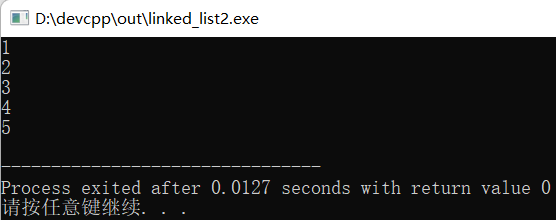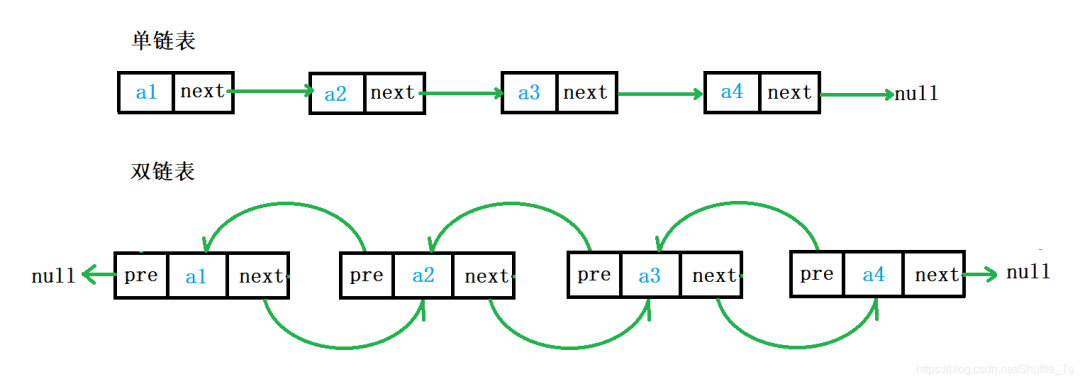實際中經常使用的一般為帶頭雙向循環鏈表。
單鏈表1
#include< stdio.h >
#include< stdlib.h >
typedef struct node
{
int data; //"數據域" 保存數據元素
struct node * next; //保存下一個數據元素的地址
}Node;
void printList(Node *head){
Node *p = head;
while(p != NULL){
printf("%dn",p- >data);
p = p - > next;
}
}
int main(){
Node * a = (Node *)malloc(sizeof(Node));
Node * b = (Node *)malloc(sizeof(Node));
Node * c = (Node *)malloc(sizeof(Node));
Node * d = (Node *)malloc(sizeof(Node));
Node * e = (Node *)malloc(sizeof(Node));
a- >data = 1;
a- >next = b;
b- >data = 2;
b- >next = c;
c- >data = 3;
c- >next = d;
d- >data = 4;
d- >next = e;
e- >data = 5;
e- >next = NULL;
printList(a);
}
結果:

這個鏈表比較簡單,實現也很原始,只有創建節點和遍歷鏈表,大家一看就懂!
單鏈表2
這個鏈表功能多一點:
- 創建鏈表
- 創建節點
- 遍歷鏈表
- 插入元素
- 刪除元素
#include< stdio.h >
#include< stdlib.h >
typedef struct node
{
int data; //"數據域" 保存數據元素
struct node * next; //保存下一個數據元素的地址
}Node;
//創建鏈表,即創建表頭指針
Node* creatList()
{
Node * HeadNode = (Node *)malloc(sizeof(Node));
//初始化
HeadNode- >next = NULL;
return HeadNode;
}
//創建節點
Node* creatNode(int data)
{
Node* newNode = (Node *)malloc(sizeof(Node));
//初始化
newNode- >data = data;
newNode- >next = NULL;
return newNode;
}
//遍歷鏈表
void printList(Node *headNode){
Node *p = headNode - > next;
while(p != NULL){
printf("%dt",p- >data);
p = p - > next;
}
printf("n");
}
//插入節點:頭插法
void insertNodebyHead(Node *headNode,int data){
//創建插入的節點
Node *newnode = creatNode(data);
newnode - > next = headNode - > next;
headNode - > next = newnode;
}
//刪除節點
void deleteNodebyAppoin(Node *headNode,int posData){
// posNode 想要刪除的節點,從第一個節點開始遍歷
// posNodeFront 想要刪除節點的前一個節點
Node *posNode = headNode - > next;
Node *posNodeFront = headNode;
if(posNode == NULL)
printf("鏈表為空,無法刪除");
else{
while(posNode- >data != posData)
{
//兩個都往后移,跟著 posNodeFront 走
posNodeFront = posNode;
posNode = posNodeFront- >next;
if (posNode == NULL)
{
printf("沒有找到,無法刪除");
return;
}
}
//找到后開始刪除
posNodeFront- >next = posNode- >next;
free(posNode);
}
}
int main(){
Node* List = creatList();
insertNodebyHead(List,1);
insertNodebyHead(List,2);
insertNodebyHead(List,3);
printList(List);
deleteNodebyAppoin(List,2);
printList(List);
return 0;
}
結果:

大家從最簡單的單鏈表開始,學習鏈表的增刪改查,然后再學習雙鏈表,最后學習雙向循環鏈表。
聲明:本文內容及配圖由入駐作者撰寫或者入駐合作網站授權轉載。文章觀點僅代表作者本人,不代表電子發燒友網立場。文章及其配圖僅供工程師學習之用,如有內容侵權或者其他違規問題,請聯系本站處理。
舉報投訴
-
數據結構
+關注
關注
3文章
573瀏覽量
40190 -
單鏈表
+關注
關注
0文章
13瀏覽量
6929
發布評論請先 登錄
相關推薦
C語言單鏈表的應用
最近在看一些開源項目,大佬的思路還是很值得去學習,今天就簡單介紹一下單鏈表的應用,配合回調函數可以玩出新花樣,廢話不多說直接看代碼!
發表于 02-17 09:22
?445次閱讀
單鏈表的缺陷是什么
單鏈表有一定的缺陷,就是單向性,只能從一個結點到下一個節點,而不能訪問到上一個結點,而循環鏈表就可以解決這一問題,當然,用雙向鏈表更加方便#include #include typed
發表于 07-14 08:09
OpenHarmony中的HDF單鏈表及其迭代器
概念為了性能考慮,嵌入式系統一般使用C語言進行開發,由于C語言標準庫沒有封裝鏈表,所以嵌入式系統一般自己設計和實現鏈表這種數據結構。單鏈表是鏈表
發表于 08-30 10:31
單鏈表學習的總結(一)
想必大多數人和我一樣,剛開始學數據結構中的單鏈表還是蠻吃力的,特別是后面的雙鏈表操作更是如此。還有就是在實踐代碼操作時,你又會感到無從下手,沒有思路。
雙向循環鏈表的創建
需要注意的是,雖然雙向循環鏈表成環狀,但本質上還是雙向鏈表,因此在雙向循環鏈表中,依然能夠找到頭指針和頭節點等。雙向循環鏈表和雙向鏈表相比,
C語言的單鏈表應用
最近在看一些開源項目,大佬的思路還是很值得去學習,今天就簡單介紹一下單鏈表的應用,配合回調函數可以玩出新花樣,廢話不多說直接看代碼!
雙向循環鏈表創建代碼
; //保存下一個數據元素的地址 struct node * prev; //保存上一個數據元素的地址 }Node; //創建表頭表示鏈表 Node* creatList() { Node * HeadNode





 如何創建單鏈表
如何創建單鏈表















評論